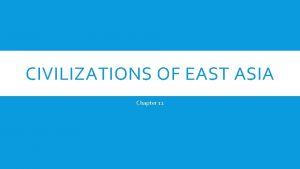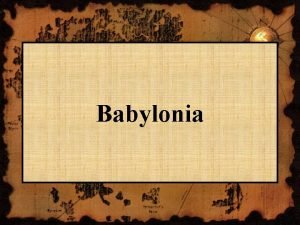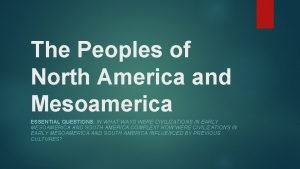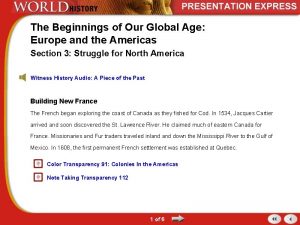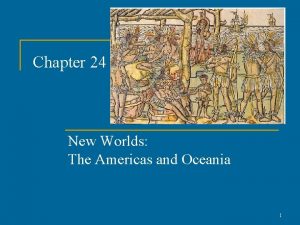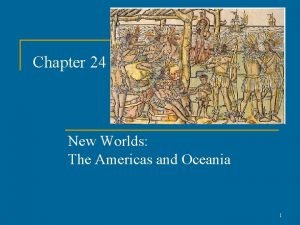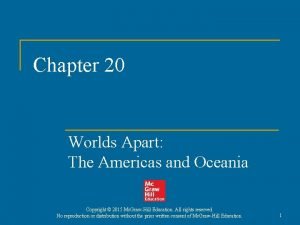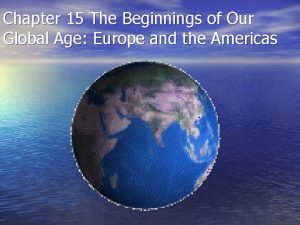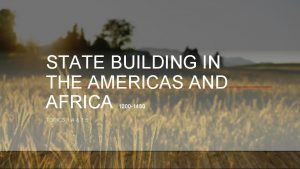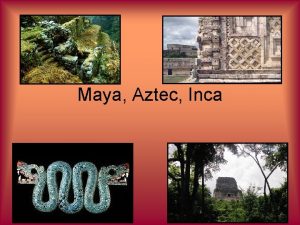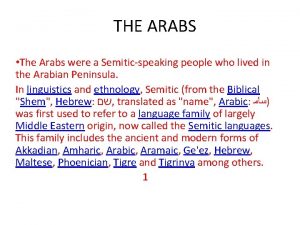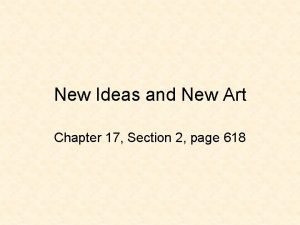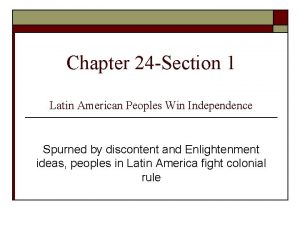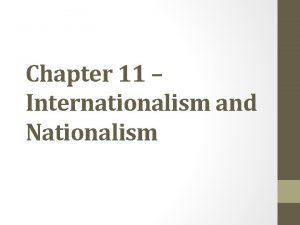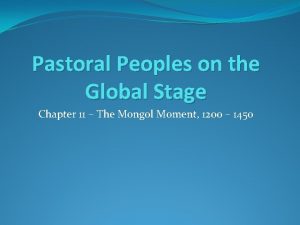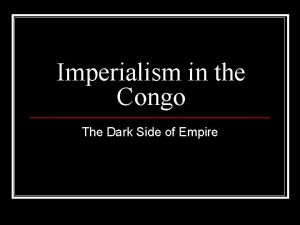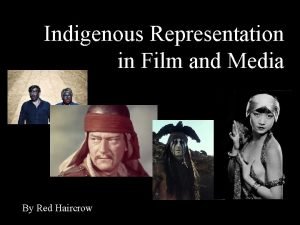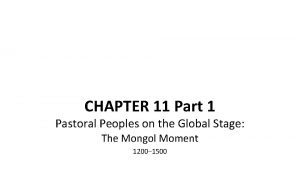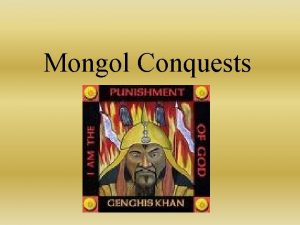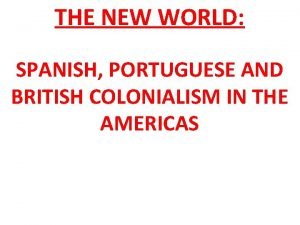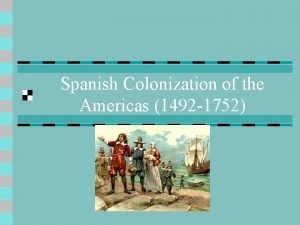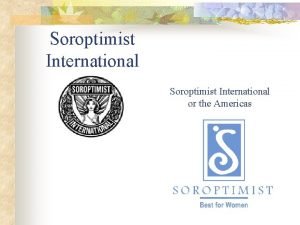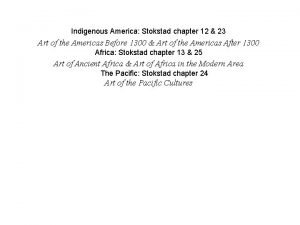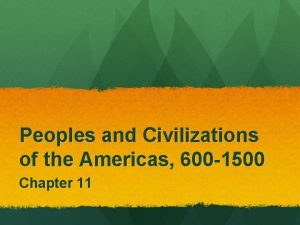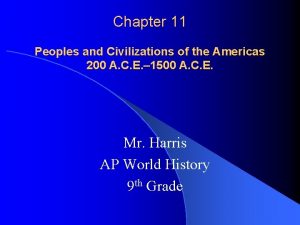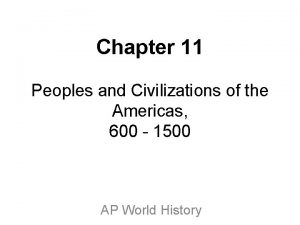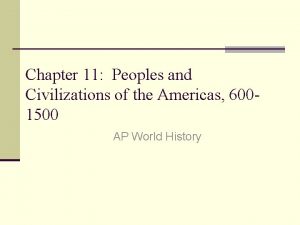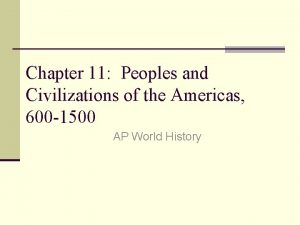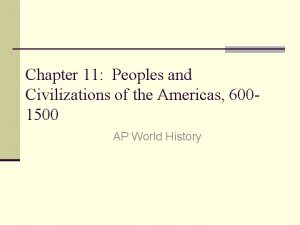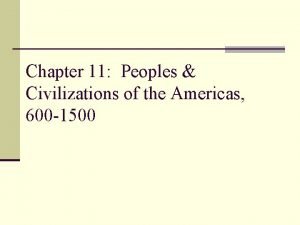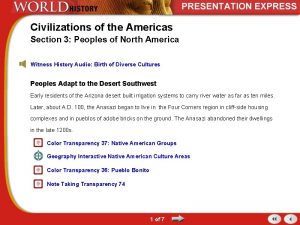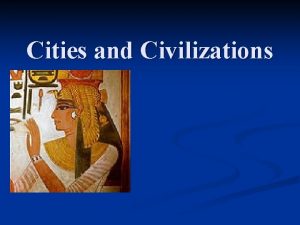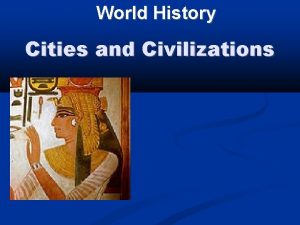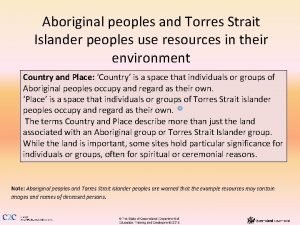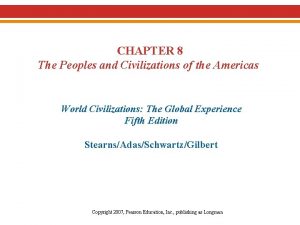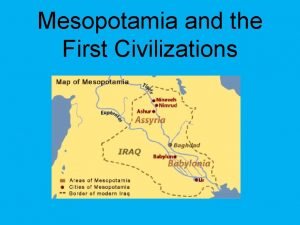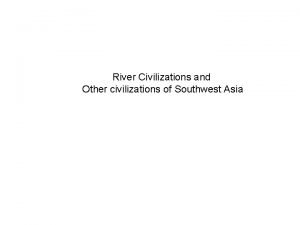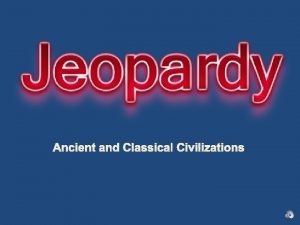Reading 7 Peoples and Civilizations of the Americas













































- Slides: 45

Reading 7 Peoples and Civilizations of the Americas, 1200 B. C. E. 1400 C. E.

Chronology from 5000 B. C. E. -1500 C. E. Empty cell Mesoamerica Northern Peoples Andean Region Empty cell Before 5000 B. C. E. Domestication of maize, beans, and squash Before 2000 B. C. E. Early urbanization 1200 B. C. E. Beginning of Olmec civilization Empty cell Before 5000 B. C. E. Domestication of potato, quinoa, manioc, and llama 5000 B. C. E. 2000 B. C. E. 1000 B. C. E. 500 B. C. E. 100 C. E. 500 C. E. 1000 C. E. 1500 C. E. Before 2000 B. C. E. Domestication of squash Before 2000 B. C. E. Urbanization and seed crops like sunflower Empty cell 2000 B. C. E. Metallurgy; domestication of sweet potato Empty cell 900 B. C. E. Beginning of Chavin civilization 400 B. C. E. End of Olmec Empty cell civilization 100 First stage of Teotihuacan temple complex 100 400 Hopewell culture in Ohio River 200 Maya early classic period Valley begins 200 B. C. E. End of Chavin civilization 450 Teotihuacan dominates central Mexico 750 Teotihuacan destroyed 500 1000 Tiwanaku and Wari control Andean highlands 700 End of Moche domination 900 Chimu begin to dominate Peru vian coast 700 beginnings of Anasazi culture in Four Corners region 200 Moche begin to dominate Peru vian coast 800 900 Maya classic era cities 800 beginnings of Mississippian culture abandoned 968 Toltec capital of Tula founded 1175 Tula destroyed 1050 1250 Cahokia reaches peak population 1150 Anasazi center of Pueblo Bonito abandoned; other Anasazi centers enter crisis after 1200 Until 1300 Culhuacan and Empty cell 1470 s End of Chimu domination Cholula continue Toltec tradition p 195

Map 8. 1 p 196

The Mesoamerican Olmec, 1200 -400 B. C. E. • most significant pre-classic society • Major centers located along the Atlantic coast of Mexico. • use of raised fields provided the agricultural surpluses the Olmec needed to sustain urban centers. • Grew maize (corn), beans, potatoes, peppers, pumpkins, avocados, cotton, and tobacco.

• Centers of early Olmec civilization • San Lorenzo, earliest • La Venta around 900 B. C. E • Tres Zapotes around 600 B. C. E • Large earthen mounds (sometimes called earthen pyramids) dominated Olmec urban centers; these cities were fundamental for administration, trade and religious practice


• It is likely that political structures were built around some form of kingship. • power rested on the control of certain commodities and the popularity of their religious practices. • Given their limited technology, Olmec architecture was very impressive. (remember no wheel/pulley) • The Olmec played a role in the early development of writing and astronomy.

Olmec Head 17 of these were found, some are 10 feet tall! p 197

Classic-Era Culture and Society in Mesoamerica, 200– 900 Teotihuacan • Large Mesoamerican city at the height of its power in 450– 600 C. E. • Population of 125, 000 to 150, 000 inhabitants • Dominated by religious structures, including pyramids and temples where human sacrifice was carried out.

• The growth of Teotihuacan was made possible by forced relocation of farm families to the city and by agricultural innovations, including irrigation works and chinampas (“floating gardens”) that increased production and thus supported a larger population.

• The elite lived in residential compounds separate from the commoners, and controlled the state bureaucracy, tax collection, and commerce. • Ruled by alliances of wealthy families rather than by kings. • The military was used primarily to protect and expand long-distance trade and to ensure that farmers paid taxes or tribute to the elite. • Teotihuacan collapsed around 750 C. E. The collapse may have been caused by mismanagement of resources and conflict within the elite, or as a result of invasion.

The Maya • The Maya were a single culture living in modern Guatemala, Honduras, Belize, and southern Mexico • But they never formed a politically unified state. Various Maya kingdoms fought each other for regional dominance. • The Maya responded to a growing population by increasing their agricultural productivity by draining swamps, building elevated fields and terraced fields, and by constructing irrigation systems. The Maya also managed forest resources to increase the production of desired products.

Maya Civilization, 250– 1400 C. E. Map 8. 2 p 200

• The largest Maya city-states dominated neighboring city-states and agricultural areas. • Large city-states constructed impressive and beautifully decorated buildings and monuments by means of very simple technology—levers and stone tools. Chichen Itza

The Great Plaza at Tikal p 201

• The Maya believed that the cosmos consisted of three layers: the heavens, the human world, and the underworld. • Temple architecture reflected this cosmology, and the rulers and elites served as priests to communicate with the residents of the two supernatural worlds. • Maya military forces fought for captives, not for territory. • Elite captives were sacrificed; commoners were enslaved. • (could compare to Carthage)

• Maya elite women participated in bloodletting rituals and other ceremonies, but they rarely held political power. Non-elite women probably played an essential role in agricultural and textile production. • The most notable Maya technological developments are the Maya calendar, mathematics, and the Maya writing system. • Most Maya city-states were abandoned or destroyed between 800 and 900 C. E. Possible reasons for the decline of Maya culture include the disruption of Mesoamerican trade resulting from the fall of Teotihuacan, environmental pressure caused by overpopulation, and increased warfare.

Mayan Writing system

The Mesoamerican Ball Game p 202

The Postclassic Period in Mesoamerica, 900 -1300 Map 8. 3 p 204

The Toltecs • Arrived in central Mexico in the 10 th C and built a civilization based on the legacy of Teotihuacan. • Innovations in the areas of politics and war. • Capital-Tula was the center of the first conquest state in the Americas. • Dual kings ruled the state—an arrangement that probably caused the internal struggle (duh…) that undermined the Toltec state around 1150 C. E. • Destroyed by invaders around 1175 C. E. • The Toltec legacy did survive in another urban area, Cholula, which contained a significant Toltec population and which survived until the early fourteenth century.

Tula p 205

Early South American Civilization: Chavín, 900– 200 B. C. E. • first major urban civilization in South America • politically and economically dominant between 900 and 250 B. C. E. • Influences stems from a combination of military strength and the appeal of its religious system explains • possessed all the essential characteristics of later Andean civilizations, including a clan-based system of labor • evidence suggests that increased warfare led to the fall of Chavín around 200 B. C. E.

Only beast of burden in the Americas…. The Llama (and alpaca, but they were used more for wool) Were also eaten, commonly in the form of jerky.

Andean Civilizations, 200 B. C. E. – 1532 C. E. Map 8. 5 p 210

Andean Civilizations, 200– 1400 Cultural Response to Environmental Challenge • The harsh environment of the high-altitude Andes, the dry coastal plain, and the tropical headwaters of the Amazon all forced the human inhabitants of these areas to organize labor efficiently and thus produce enough food to live.

• The basic unit of Andean labor organization was the clan (ayllu). Clans held land collectively, and clan members were obligated to assist each other in production and to supply goods and labor to the clan chief. • The territorial states organized after 1000 C. E. introduced the institution of the mit’a, which required each ayllu to provide a set number of workers each year to provide labor for religious establishments, the royal court, or the aristocracy. (*the mit’a system is going to come back in our discussion when the Europeans show up)

• The Andean region is divided into four major ecological zones: the coast, mountain valleys, higher elevations, and the Amazonian region. • Each region produced different goods, and these goods were exchanged among the various regions through a network of trade routes. • The ayllu system gave powerful groups the ability to bring in resources from all of these zones though a process of communication and vertical integration.

The Early Intermediate Period Moche • The Moche culture emerged in the north coastal region of Peru in about 200 C. E. The Moche used forced labor to construct an extensive irrigated agriculture that produced maize, quinoa, beans, and manioc. • Moche society was stratified and theocratic. Wealth and power were concentrated in the hands of an elite of priests and military leaders who lived atop large platforms and decorated themselves with magnificent clothing, jewelry, and tall headdresses.

• Moche artisans were skilled in the production of textiles, portrait vases, and metallurgy. • Gold and silver were used for decorative purposes • copper and copper alloy were used for farm tools and weapons. • The decline and fall of the Moche civilization may be attributed to a series of natural disasters in the sixth century and to pressure from the warlike Wari people in the eighth century.

Tiwanaku and Wari • The civilization of Tiwanaku, in Bolivia, experienced increased agricultural productivity and urbanization in the years following 200 C. E. • Tiwanaku cultivated potatoes and grains on raised fields reclaimed from marshland. • Tiwanaku’s urban construction included a large terraced pyramid, walled enclosures, and a reservoir.

• Construction was done with large stones quarried, moved, and laid by thousands of laborers working with simple technology and copper alloy tools. • Tiwanaku society was highly stratified, ruled by a hereditary elite. • The Wari culture was located near the city of Ayucucho, Peru. Wari had contact with Tiwanaku but was a separate culture; the city was built without central planning, with different techniques, and on a much smaller scale than Tiwanaku. Both Tiwanaku and Wari declined to insignificance by 1000 C. E.

Chimú • This state emerged in the Late Intermediate period (1000 -1476 C. E. ) on the northen coast of Peru, where the Moche had once ruled. • Chimú survived for over four hundred years, mainly because of an efficient administrative system and a productive agricultural regime. • Chimú ultimately fell victim to the powerful Inka, not to internal political disputes or environmental catastrophe.

Terrace farming

In the South American Andes, farmers have used terraces, known as andenes, for over a thousand years to farm potatoes, maize, and other native crops. They lived in the mountains. Flatlands were rare. So, they simply created flat land by building steps of land for agriculture down the mountainside. Credit for the invention often goes to the Inca, but many historians credit the Wari or Tiwanaku. India devises a system of terraces as well, although the two cultures had no contact.

Culture Areas of North America Map 8. 4 p 207

Northern Peoples Southwestern Desert Cultures • Irrigation-based agriculture was introduced to Arizona from Mexico around 300 B. C. E. • The most notable Mexican-influenced civilization of the area was the Hohokam, who constructed extensive irrigation works in the Salt and Gila valleys around 1000 C. E. • The more influential Anasazi developed a maize, rice, and bean economy and constructed underground buildings (kivas) in the Arizona/New Mexico/Colorado/Utah region around 450– 750 C. E.

Mesa Verde Cliff Dwelling p 208


• The large Anasazi community at Chaco Canyon had a population of about 15, 000 • people engaged in hunting, trade, and irrigated agriculture. • Chaco Canyon people seem to have exerted some sort of political or religious dominance over a large region. • The Anasazi civilization declined in the twelfth and thirteenth centuries as a result of drought, overpopulation, and warfare.

Mound Builders: The Hopewell and Mississippian Cultures • The Hopewell culture developed out of the earlier Adena culture around 100 C. E. • It was based in the Ohio Valley, but its trade and influence extended as far as Illinois, Michigan, Wisconsin, New York and Ontario, and south to Florida. • The Hopewell economy was based on hunting and gathering and was supplemented by agriculture.

• The major Hopewell centers were ruled by hereditary chiefs. • Chiefs served as priests and managed secular affairs such as long-distance trade. • The Hopewell people built large mounds both as burial sites and as platforms upon which temples and residences of chiefs were constructed.

• Hopewell sites were abandoned around 400 C. E. , but the Hopewell technology and moundbuilding are linked to the development of the Mississippian culture (700– 1500 C. E. ). • Urbanized Mississippian chiefdoms were made possible by increased agricultural productivity, the bow and arrow, and expanded trade networks. • The largest Mississippian center was Cahokia, in present day Illinois, with a population of about 30, 000 around 1200 C. E. • Cahokia was abandoned around 1250 perhaps because of climate changes and population pressure.

Conclusion Comparisons These Mesoamerican and Andean societies expanded and thrived ultimately not only because of their administrative abilities and their efficient use of natural resources, but also because of their military prowess. These states all responded to difficult environmental challenges with a variety of innovations in agricultural cultivation and the mass organization of labor. They also constructed urban centers which served as sites for governmental, economic and religious activities.

Contrasts Some differences persisted in these regions however, with Mesoamerican cultures developing elementary market systems to distribute resources, while Andean societies relied more on managed exchanges and reciprocal labor obligations.
 Pre reading while reading and post reading activities
Pre reading while reading and post reading activities Chapter 11 civilizations of east asia
Chapter 11 civilizations of east asia Chapter 14 test form a pre columbian america answers
Chapter 14 test form a pre columbian america answers Many territories and peoples controlled by one government
Many territories and peoples controlled by one government The peoples of north america and mesoamerica
The peoples of north america and mesoamerica The beginning of our global age europe and the americas
The beginning of our global age europe and the americas Chapter 24 new worlds the americas and oceania
Chapter 24 new worlds the americas and oceania New worlds the americas and oceania
New worlds the americas and oceania Chapter 24 the americas and oceania
Chapter 24 the americas and oceania Ap world history chapter 20 the americas and oceania
Ap world history chapter 20 the americas and oceania The beginnings of our global age europe and the americas
The beginnings of our global age europe and the americas State building in the americas and africa
State building in the americas and africa Aztec farming
Aztec farming Map of the inca maya and aztec
Map of the inca maya and aztec Semitic peoples origin
Semitic peoples origin Maturity continuum model by stephen
Maturity continuum model by stephen John calvin peoples
John calvin peoples Latin american people win independence
Latin american people win independence Clap your hands all ye peoples make a joyful noise
Clap your hands all ye peoples make a joyful noise Latin american peoples win independence
Latin american peoples win independence World council of indigenous peoples
World council of indigenous peoples The grange apush
The grange apush Chapter 11 pastoral peoples on the global stage
Chapter 11 pastoral peoples on the global stage Respect other people's time and bandwidth.
Respect other people's time and bandwidth. Peoples palace qmul
Peoples palace qmul Netiquette commandments
Netiquette commandments Chachua government primary school
Chachua government primary school Latin american peoples win independence
Latin american peoples win independence Peoples speke
Peoples speke Peoples business
Peoples business 8 habits stephen covey
8 habits stephen covey Indigenous representation in film
Indigenous representation in film Joel shaul
Joel shaul Chapter 11 pastoral peoples on the global stage
Chapter 11 pastoral peoples on the global stage Paroles imagine lennon
Paroles imagine lennon Peoples home equity inc
Peoples home equity inc Que países conforman la gran colombia
Que países conforman la gran colombia Nomadic peoples who herded domesticated animals
Nomadic peoples who herded domesticated animals Latin american peoples win independence
Latin american peoples win independence The narratives that vanquished peoples
The narratives that vanquished peoples Latin american peoples win independence
Latin american peoples win independence Spanish caste system in the americas
Spanish caste system in the americas Spanish colonization of the americas
Spanish colonization of the americas Soroptimist international of the americas
Soroptimist international of the americas Art of the americas before 1300
Art of the americas before 1300 Ib history ib exam questions
Ib history ib exam questions

